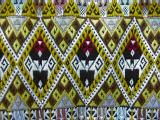 THAILAND--Part Five
THAILAND--Part Five
The northern part of Thailand is quite different from the center. First of all, it LOOKS different: it is very mountainous rather than flat, with many powerful rivers and dense forests. It feels different, too, with the higher latitude and the mountains contributing to cooler temperatures and a generally more comfortable climate. And, it even sounds different: while most people can speak central Thai, they prefer to speak the northern Thai dialect, which is quite different. And the hill tribes who live out in the mountains speak completely different languages of their own, not to mention living very different lives from the Tai majority. The second largest city in the country, Chiang Mai, is here; it is a major arts and crafts center where you can find beautiful painted umbrellas and products made of silver, silk, lacquer and teak. In the southern part of the region, the earliest and perhaps greatest center in Thai history is located: Sukhothai. Check it out!
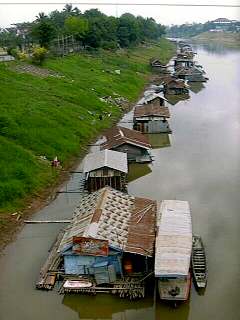 Coming
from the south, the first big city you reach in the north is Phitsanoulok.
As in Damnoen Saduak, much of the life there centers around the river; some
people even live on it, as do these people in their houseboats.
Coming
from the south, the first big city you reach in the north is Phitsanoulok.
As in Damnoen Saduak, much of the life there centers around the river; some
people even live on it, as do these people in their houseboats.
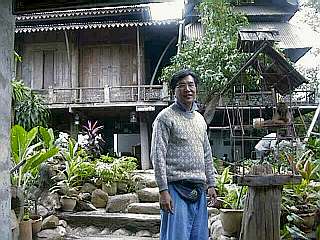 When
I got into Phitsanoulok, I checked in at the International Youth Hostel.
This is a special IYH run by this man, Sapachai, who quit his high-tech
job in Bangkok to come back to his boyhood home and start this hostel. He
took teak wood that was being thrown away from old houses to build the hostel.
Teak is a very beautiful wood; it also resists mildewing and being eaten
by insects, and there are buildings built of it that are a thousand years
old. Because of these characteristics it is highly valued, and whole teak
forests have been logged. At this point, less than ten percent of the original
teak forests of Thailand remain, to the disadvantage of all the other wildlife
that lived in those forests, too. While there are laws protecting the forests
that are left, the logging continues.
When
I got into Phitsanoulok, I checked in at the International Youth Hostel.
This is a special IYH run by this man, Sapachai, who quit his high-tech
job in Bangkok to come back to his boyhood home and start this hostel. He
took teak wood that was being thrown away from old houses to build the hostel.
Teak is a very beautiful wood; it also resists mildewing and being eaten
by insects, and there are buildings built of it that are a thousand years
old. Because of these characteristics it is highly valued, and whole teak
forests have been logged. At this point, less than ten percent of the original
teak forests of Thailand remain, to the disadvantage of all the other wildlife
that lived in those forests, too. While there are laws protecting the forests
that are left, the logging continues.
 Walking
into the center of town, I came upon this movie poster. Like in most places
I've been in this part of the world, the most popular movies are the action,
shoot-'em-up kind. This is obviously no exception. You can also see Thai
writing, which is nothing like the Roman system we use to write English,
Spanish, etc.
Walking
into the center of town, I came upon this movie poster. Like in most places
I've been in this part of the world, the most popular movies are the action,
shoot-'em-up kind. This is obviously no exception. You can also see Thai
writing, which is nothing like the Roman system we use to write English,
Spanish, etc.
 The
main reason I came to Phitsanoulok, though, was to visit the famous Buddha-making
foundry of Sergeant Major Thawi. Outside the foundry was this spirit house.
Virtually every house and business has a spirit house like this, installed
with the help of a Brahmin (high-caste Hindu), designed to shelter the spirits
of the site so they don't enter your own house and cause mischief. This
is an example of the animist beliefs the Thais join together with
their Buddhist ones. These animist beliefs have their origins in the distant
past, when the Thai people came from China and Vietnam and worshipped the
variety of spirits they believed live in every living thing (animals AND
plants) and even non-living things like rocks, the air and the sun. It is
also an example of the syncretism that is a part of Thai culture,
where very different ideas or practices can be joined together in daily
life -- here, those related to Buddhism, animism AND Hinduism.
The
main reason I came to Phitsanoulok, though, was to visit the famous Buddha-making
foundry of Sergeant Major Thawi. Outside the foundry was this spirit house.
Virtually every house and business has a spirit house like this, installed
with the help of a Brahmin (high-caste Hindu), designed to shelter the spirits
of the site so they don't enter your own house and cause mischief. This
is an example of the animist beliefs the Thais join together with
their Buddhist ones. These animist beliefs have their origins in the distant
past, when the Thai people came from China and Vietnam and worshipped the
variety of spirits they believed live in every living thing (animals AND
plants) and even non-living things like rocks, the air and the sun. It is
also an example of the syncretism that is a part of Thai culture,
where very different ideas or practices can be joined together in daily
life -- here, those related to Buddhism, animism AND Hinduism.
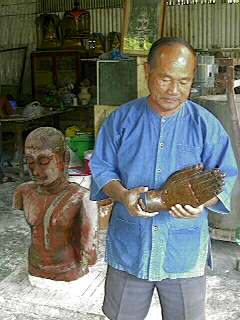 Dr.
Thawi's forge is famous because of his insistence on using the ancient,
traditional "lost-wax" method of making Buddhas. He focuses entirely on
making small-scale copies of the Chinnarat Buddha, which is located in Phitsanoulok
and is one of the most famous of all Buddha images in the world. Dr. Thawi
is very involved in the work of his twenty or so employees; here, he is
carefully looking over some of their work.
Dr.
Thawi's forge is famous because of his insistence on using the ancient,
traditional "lost-wax" method of making Buddhas. He focuses entirely on
making small-scale copies of the Chinnarat Buddha, which is located in Phitsanoulok
and is one of the most famous of all Buddha images in the world. Dr. Thawi
is very involved in the work of his twenty or so employees; here, he is
carefully looking over some of their work.
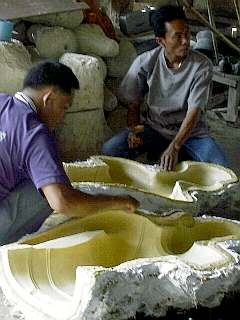 In
the lost wax method, a model of the Buddha to be eventually made out of
bronze is first sculpted out of clay and sand. The model is covered in plaster
to make a mold; then, as you see here, the inside of the mold (which is
in two parts) is painted with layer after layer of wax. Once the wax has
solidified, the two halves are joined together and more plaster is poured
INSIDE, between the two halves. The result at this stage is a thin wax image
of the Buddha sandwiched in plaster. The next step...
In
the lost wax method, a model of the Buddha to be eventually made out of
bronze is first sculpted out of clay and sand. The model is covered in plaster
to make a mold; then, as you see here, the inside of the mold (which is
in two parts) is painted with layer after layer of wax. Once the wax has
solidified, the two halves are joined together and more plaster is poured
INSIDE, between the two halves. The result at this stage is a thin wax image
of the Buddha sandwiched in plaster. The next step...
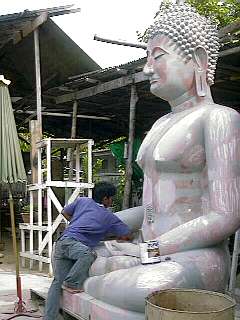 ...is
to remove the plaster, leaving the wax image alone. This one is HUGE, but
still not as big as the original. Next, the wax image is smoothed out, as
this sculptor is doing, to remove any imperfections. Once this is done...
...is
to remove the plaster, leaving the wax image alone. This one is HUGE, but
still not as big as the original. Next, the wax image is smoothed out, as
this sculptor is doing, to remove any imperfections. Once this is done...
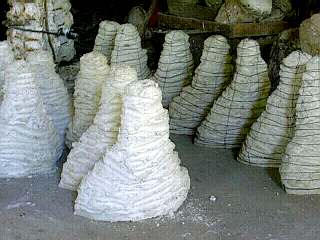 ...the
wax image is once again sandwiched in plaster. This time, the whole package
is tightly wrapped in wire, and holes are drilled into the bottom of the
plaster. Then...
...the
wax image is once again sandwiched in plaster. This time, the whole package
is tightly wrapped in wire, and holes are drilled into the bottom of the
plaster. Then...
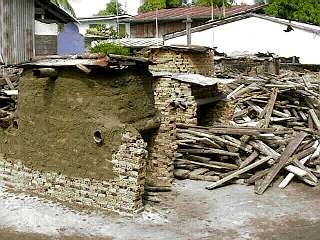 ...the
wired molds are put into a wood-fired kilns like these. The wax melts and
pours out of the holes in the plaster coating, leaving a plaster mold with
the thin-skinned Buddha image left inside where the wax used to be. In the
final step of the molding process, molten bronze is then poured into the
mold, and when it is cooled the plaster is cracked off to reveal the finished
Buddha -- in bronze! Of course, there's still polishing, sand papering,
painting and even gilding (plating with gold leaf) work to be done, but
the basic sculpture is there.
...the
wired molds are put into a wood-fired kilns like these. The wax melts and
pours out of the holes in the plaster coating, leaving a plaster mold with
the thin-skinned Buddha image left inside where the wax used to be. In the
final step of the molding process, molten bronze is then poured into the
mold, and when it is cooled the plaster is cracked off to reveal the finished
Buddha -- in bronze! Of course, there's still polishing, sand papering,
painting and even gilding (plating with gold leaf) work to be done, but
the basic sculpture is there.
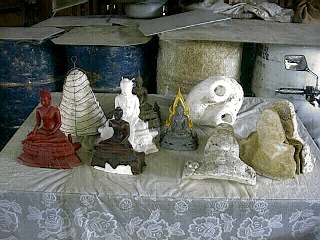 The
big advantage of this method, according to Dr. Thawi, is its faithfulness
to the original way of making the Buddha. The results are beautiful, with
the whole cast image being of one piece rather than joined-together parts,
as with other approaches. This picture shows all the stages of the lost-wax
casting approach. In the center is a final product, which is a replica of
the original Chinnarat Buddha.
The
big advantage of this method, according to Dr. Thawi, is its faithfulness
to the original way of making the Buddha. The results are beautiful, with
the whole cast image being of one piece rather than joined-together parts,
as with other approaches. This picture shows all the stages of the lost-wax
casting approach. In the center is a final product, which is a replica of
the original Chinnarat Buddha.
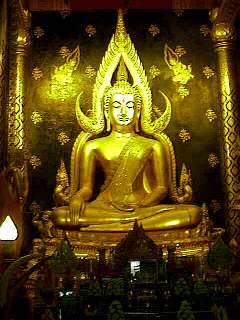 And,
here is the original Chinnarat Buddha! What makes it special is the flaming
halo around its head; at the bottom, it the flame turns into dragon-serpent
heads. The style is also from the elegant Sukhothai tradition -- which is
the next place I visited.
And,
here is the original Chinnarat Buddha! What makes it special is the flaming
halo around its head; at the bottom, it the flame turns into dragon-serpent
heads. The style is also from the elegant Sukhothai tradition -- which is
the next place I visited.
 Sukhothai
is considered the "cradle" of Thai civilization. In the twelfth and thirteenth
centuries, it was indeed the largest and most powerful of all the Tai kingdoms.
Evidence suggests that the Tai people are originally from an area called
Sipsongpanna (Xishuangbanna in Chinese), which extends from the city of
Kunming in southern China's Yunnan province to the south and east into northern
Vietnam; they migrated into northern Thailand and lived under the rule of
the Khmer, who were centered in the area that is now Cambodia, until defeating
them in battle in the 13th century.
Sukhothai
is considered the "cradle" of Thai civilization. In the twelfth and thirteenth
centuries, it was indeed the largest and most powerful of all the Tai kingdoms.
Evidence suggests that the Tai people are originally from an area called
Sipsongpanna (Xishuangbanna in Chinese), which extends from the city of
Kunming in southern China's Yunnan province to the south and east into northern
Vietnam; they migrated into northern Thailand and lived under the rule of
the Khmer, who were centered in the area that is now Cambodia, until defeating
them in battle in the 13th century.
Sukhothai was a spectacular city at its height. (To read about what it was like, see box below.) The people of Sukhothai adopted the Buddhist traditions of the people they encountered when they first came to the area, called the Mon, then built glorious monuments to their beliefs that stand to this day. The Buddha figures at Sukhothai are widely thought to be among the most beautiful in the world.
|
THE GREAT CITY OF SUKHOTHAI The greatest king of Sukhothai was Ram Khamhaeng. He is known mostly from an ancient inscription that bears his name, which gives a wonderful description of life in Sukhothai under his rule. Here's a part of that inscription: "In Ram Khamhaeng's time, the city of Sukhothai is prosperous. There is fish in the water, there is rice in the fields. The ruler of the country does not impose taxes on his subjects who travel together along the roads, taking cattle to the market, or riding horses for sale. Whoever wishes to trade in elephants or in horses, may do so; whoever wishes to trade in silver or gold, may do so. If a common man, a nobleman, or a chief becomes sick, dies or disappears, his house, his clothes, his elephants, his family, his rice granaries, his slaves, and his areca and betel orchards are all inherited by his children. If the common people, nobles or chiefs have a dispute, the king investigates the matter thoroughly, and then passes judgment for his subjects with complete impartiality. He does not connive with thieves and receivers of stolen goods. If he sees another person's rice, he does not covet it; and if he sees another person's treasures, he is not jealous. Whoever rides an elephant to meet him and places his own country under his protection, receives assistance. If the stranger does not have any elephants, horses, servants, wives, silver, or gold, he gives him some, and then asks him to consider himself at home. If he captures warriors or enemy soldiers, he neither kills nor ill treats them. There is a bell hanging in front of the palace gate; if an inhabitant of the kingdom has any complaint or any matter that is deeply bothering him and torturing his soul, and he wishes to let the king know about it, it is not difficult: all he has to do is ring the bell which is hanging there. Every time King Ram Khamhaeng hears such an appeal, he asks the plaintiff about the matter and passes judgment with complete impartiality." From "Thailand: Land of Contrasts" by Titima Suthiwan and Uri Tadmor, published in 1998 by the Center for Southeast Asian Studies, School of Hawaiian, Asian an Pacific Studies, University of Hawai'i |
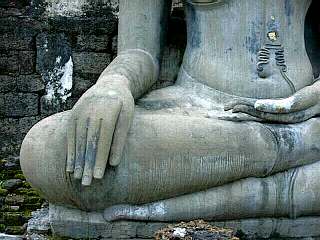 What
characterizes the Buddha sculptures at Sukhothai is their "boneless"
look, so that finger, elbow, hand and leg joints appear to be completely
supple. This is meant to express the state of "nibbana" (or nirvana)
the Buddha achieved...
What
characterizes the Buddha sculptures at Sukhothai is their "boneless"
look, so that finger, elbow, hand and leg joints appear to be completely
supple. This is meant to express the state of "nibbana" (or nirvana)
the Buddha achieved...
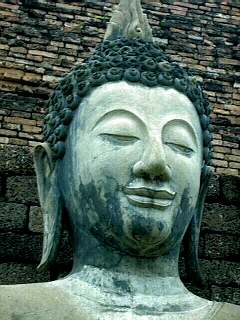 ...a
state of "non-being". His lack of physical tension on achieving enlightenment
is evident in the face of this particular sculpture. People come from all
over the world to see these wonderful sculptures; the sense of peace throughout
the city is really incredible.
...a
state of "non-being". His lack of physical tension on achieving enlightenment
is evident in the face of this particular sculpture. People come from all
over the world to see these wonderful sculptures; the sense of peace throughout
the city is really incredible.
Read another travel adventure:
|
Diary Entry: December 17, 1998 Have you ever been sitting around, watching TV or something equally brainless; your mind is sort of vacuumed empty, and you hear your Mom saying "Close your mouth or a fly will fly in!" because your jaw's dropped down almost to the floor? I can suggest an exercise to practice keeping your mouth TOTALLY shut. It's guaranteed to work. Just ride a motorbike around at dusk in the tropics. I was doing just that, on my way back from Sukhothai to Phitsanoulok. As the sun set, hundreds of bats came out. Why? DINNER! There are literally thousands of buzzing, biting things out at that time, and the bats have a feast. If you're riding a motorbike, the insects seems almost as thick as rain. I could have used a pair of windshield wipers on my glasses -- one big fat one splatted onto one of my lenses, blotting out half the vision in that eye. At one point, a bug got caught in my mustache. I' not sure what its scientific name is, but I have my own name for it: "StinkBug". I squished it immediately, but that only made it worse. I had to stand up to the strong smell of -- well, dookie, really -- for the whole next hour of my ride. It even gave me a new look: when I got back to my hotel, I had to shave off my mustache to get rid of the smell. I can only imagine what might have happened if I'd had my mouth open during the ride, like in front of that TV. I learned not to do THAT a long, long time ago. Let's just say I learned from experience. (So now my students know why I REALLY like to serve cricket sushi in my classes!) |